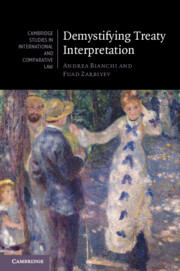Book contents
- Demystifying Treaty Interpretation
- Cambridge Studies in International and Comparative Law: 188
- Demystifying Treaty Interpretation
- Copyright page
- Contents
- Figures
- Preface
- Abbreviations
- 1 The Province of the Rules of Treaty Interpretation
- 2 The Interpreter’s Self
- 3 The Genealogy of the Contemporary Regime of Treaty Interpretation
- 4 Textualism
- 5 Intentionalism
- 6 What’s the Purpose of ‘Object and Purpose’?
- 7 Supplementary Means
- 8 The Magic of Systemic Integration
- 9 Inferential Reasoning and Its Consequences
- 10 Time and Treaty Interpretation
- 11 Text, Author, and Interpretive Control
- 12 Power, Persuasion, and Authority
- Annex Vienna Convention on the Law of Treaties 1969
- Index
- Cambridge Studies in International and Comparative Law
6 - What’s the Purpose of ‘Object and Purpose’?
Published online by Cambridge University Press: 07 March 2024
- Demystifying Treaty Interpretation
- Cambridge Studies in International and Comparative Law: 188
- Demystifying Treaty Interpretation
- Copyright page
- Contents
- Figures
- Preface
- Abbreviations
- 1 The Province of the Rules of Treaty Interpretation
- 2 The Interpreter’s Self
- 3 The Genealogy of the Contemporary Regime of Treaty Interpretation
- 4 Textualism
- 5 Intentionalism
- 6 What’s the Purpose of ‘Object and Purpose’?
- 7 Supplementary Means
- 8 The Magic of Systemic Integration
- 9 Inferential Reasoning and Its Consequences
- 10 Time and Treaty Interpretation
- 11 Text, Author, and Interpretive Control
- 12 Power, Persuasion, and Authority
- Annex Vienna Convention on the Law of Treaties 1969
- Index
- Cambridge Studies in International and Comparative Law
Summary
How does one ascertain the object and purpose of a treaty? Can a treaty have more than one object and purpose? What does giving effect to the object and purpose of a treaty mean in practice? Despite such fundamental uncertainties surrounding them, the ‘object and purpose’ are widely resorted to in the practice of treaty interpretation. This chapter argues that the object and purpose doctrine is coextensive with a large amount of interpretive discretion. The identification of the object and purpose of a treaty a largely indeterminate process, and the assumption that the treaty makers necessarily want the object and purpose of their treaty to be implemented under all circumstances leaves the treaty interpreter with considerable normative power that can hardly be resisted given the very terms of the assumption. The chapter argues that consideration of the finality of a treaty cannot be an exercise in abstract logic, but meet the requirements of practical reason.
Keywords
Information
- Type
- Chapter
- Information
- Demystifying Treaty Interpretation , pp. 118 - 141Publisher: Cambridge University PressPrint publication year: 2024
